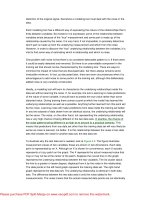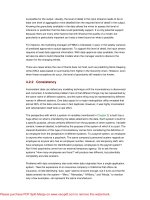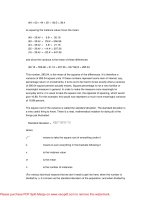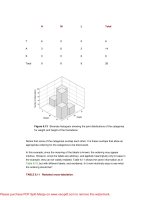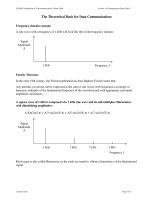Adaptive p2p platform for data sharing
Bạn đang xem bản rút gọn của tài liệu. Xem và tải ngay bản đầy đủ của tài liệu tại đây (1.01 MB, 215 trang )
ADAPTIVE P2P PLATFORM FOR DATA SHARING
By
Ng Wee Siong
SUBMITTED IN PARTIAL FULFILLMENT OF THE
REQUIREMENTS FOR THE DEGREE OF
DOCTOR OF PHILOSOPHY
AT
NATIONAL UNIVERSITY OF SINGAPORE
REPUBLIC OF SINGAPORE
MARCH 2004
c
Copyright by Ng Wee Siong, 2004
NATIONAL UNIVERSITY OF SINGAPORE
DEPARTMENT OF
COMPUTER SCIENCE
The undersigned hereby certify that they have read and
recommend to the Faculty of Graduate Studies for acceptance a
thesis entitled “Adaptive P2P Platform for Data Sharing”
by Ng Wee Siong in partial fulfillment of the requirements for the
degree of Doctor of Philosophy.
Dated: March 2004
External Examiner:
Karl Aberer, Alon Halevy
Research Supervisor:
Ooi Beng Chin
Examing Committee:
Ang Chuan Heng
Teo Yong-Meng
Anthony K. H. Tung
ii
Table of Contents
Table of Contents iii
List of Tables vi
List of Figures vii
Summary xi
Acknowledgements xiv
1 Introduction 1
1.1 P2PApplications 4
1.2 Motivation 6
1.3 ThesisGoalandContributions 10
1.4 OrganizationoftheThesis 12
2 Related Work 14
2.1 Introduction 14
2.2 P2PTaxonomies 15
2.2.1 ComparisonofArchitectures 19
2.3 SearchMechanismandAlgorithms 21
2.3.1 DHT-basedSchemes:TheLimitations 30
2.4 Agents and P2P Computing: A Promising Combination of Paradigms 31
2.4.1 Merging of Infrastructures: P2P and Agent . . . . . . . . . . . 32
2.5 P2P: From the Data Management Perspective . . . . . . . . . . . . . 36
2.5.1 Complexity of Data Management in P2P . . . . . . . . . . . . 37
2.5.2 Data Modeling and Query Capabilities . . . . . . . . . . . . . 40
2.5.3 DataCachingandPlacement 43
2.5.4 Schema Mediation and Data Integration . . . . . . . . . . . . 44
iii
2.6 Summary 45
3 The Architecture of BestPeer: A Self-Configurable P2P System 47
3.1 TheBestPeerNetwork 49
3.2 FeaturesofBestPeer 54
3.2.1 Integration of Mobile Agents and P2P Technologies . . . . . . 54
3.2.2 ResourceSharing 56
3.2.3 ReconfigurableBestPeerNetwork 58
3.2.4 Location-Independent Global Names Lookup Server . . . . . . 62
3.3 APerformanceStudy 64
3.3.1 ExperimentalSetup 65
3.3.2 OnDifferentNetworkTopology 67
3.3.3 ComparisonofBestPeerandGnutella 70
3.4 Summary 72
4 PeerDB: A P2P-based System for Distributed Data Sharing 74
4.1 P2P Distributed Data Management: What Is It? . . . . . . . . . . . 75
4.1.1 P2P vs Distributed Database Systems . . . . . . . . . . . . . 76
4.1.2 HealthCare 77
4.1.3 GenomicData 78
4.1.4 DataCaching 78
4.2 PeeringUpforDistributedDataSharing 79
4.2.1 ArchitectureofaPeerDBNode 79
4.2.2 Sharing Data without Shared Schema . . . . . . . . . . . . . . 81
4.2.3 Agent Assisted Query Processing . . . . . . . . . . . . . . . . 85
4.2.4 MonitoringStatistics 88
4.2.5 CacheManagement 89
4.3 APerformanceStudy 90
4.3.1 OnRelationMatchingStrategy 91
4.3.2 OnPeerDBPerformance 93
4.4 Summary 101
5 PeerOLAP: An Adaptive P2P Network for Distributed Caching of
OLAP Results
1
103
5.1 Introduction 103
5.2 Background 106
5.3 ThePeerOLAPNetwork 108
5.4 PeerArchitecture 111
5.4.1 CostModel 113
iv
5.4.2 QueryProcessing 114
5.4.3 CachingPolicy 118
5.4.4 NetworkReorganization 123
5.5 ExperimentalEvaluation 126
5.5.1 PeerOLAP vs. Client-Side Cache Architecture . . . . . . . . . 128
5.5.2 Evaluation of the Query Optimization Strategies . . . . . . . . 131
5.5.3 Evaluation of the Caching Policies . . . . . . . . . . . . . . . . 133
5.5.4 Effect of Network Reorganization . . . . . . . . . . . . . . . . 141
5.6 Summary 144
6 FuzzyPeer: Answering Similarity Queries in P2P Networks 146
6.1 Introduction 146
6.2 SystemDescription 149
6.2.1 PrototypeImplementation 151
6.3 QueryProcessing 153
6.3.1 Static Query Freezing (SQF) . . . . . . . . . . . . . . . . . . . 155
6.3.2 Adaptive Query Freezing (AQF) . . . . . . . . . . . . . . . . . 158
6.3.3 Similarity Query Freezing (simQF) . . . . . . . . . . . . . . . 161
6.3.4 Multiple-featureQueries 162
6.3.5 DealingwithCycles 164
6.4 ExperimentalEvaluation 166
6.4.1 Static Query Freezing . . . . . . . . . . . . . . . . . . . . . . . 168
6.4.2 Adaptive Query Freezing . . . . . . . . . . . . . . . . . . . . . 177
6.4.3 Similarity Query Freezing Algorithm . . . . . . . . . . . . . . 180
6.4.4 Multiple-featureQueries 182
6.5 Summary 184
7 Conclusion 185
7.1 FutureScopeofWork 187
Bibliography 189
v
List of Tables
2.1 ThreeDifferentArchitecturesofP2P 19
4.1 Precision and Recall for Varying Threshold Values (Synthetic Data) . 92
4.2 Precision and Recall for Varying Threshold Values (Real Data) . . . . 93
5.1 ParametersDerivedfromthePrototype 125
5.2 The Schema of the APB Dataset. The values represent the size of the
domain in each dimension at the corresponding level of hierarchy. . . 126
5.3 TheSchemaoftheSYNTHDataset 127
6.1 ParametersDerivedfromthePrototype 166
6.2 FirstDelay(Stream
BEST
) – FisrtDelay(Stream
ALL
) 176
6.3 Precision(Stream
ALL
) – Precision(Stream
BEST
) 176
vi
List of Figures
1.1 Client-ServerComputingModel 2
2.1 ATaxonomyofComputerSystems 15
2.2 CentralizedP2PArchitecture 16
2.3 FullyAutonomousP2PArchitecture 18
2.4 P2PwithSupernodes 19
2.5 Breadth-first Routing and Locating; Dash-box Denotes Routing Table,
Oval-box Denotes Local Shared Objects, Dash-arrow Denotes Download 22
2.6 Depth-first Routing and Locating; Dash-box Denotes Routing Table,
Oval-boxDenotesLocalSharedObjects 24
2.7 Relationship of predecessor(p), successor(p), k and p 25
2.8 Key Assignment in Finger Table . . . . . . . . . . . . . . . . . . . . . 26
2.9 ChordRoutingStrategy 27
2.102-DCoordinateOverlaywithFiveNodes 28
2.11CANRoutingStrategy 29
2.12InfrastructureofP2PandAgents 33
2.13 Hilbert Curve for Approximation Level 2 and Level 3 . . . . . . . . . 42
3.1 BestPeerNetwork 50
3.2 SearchAlgorithm 53
3.3 ExampleofBestPeer’sReconfigurableFeature 59
3.4 Algorithm KeepBestPeers. . . . . . . . . . . . . . . . . . . . . . . . . 61
3.5 ExperimentalEnvironment 65
vii
3.6 Different Network Topologies Used in the Experiment . . . . . . . . . 67
3.7 OnNetworkTopologies 69
3.8 BestPeervsGnutella 72
4.1 PeerDBNodeArchitecture 81
4.2 Keywords for Relation/Attribute Names . . . . . . . . . . . . . . . . 84
4.3 PeerDBInterface 90
4.4 EffectofStorageCapacity 96
4.5 RateofReturningAnswers 97
4.6 NumberofAnswersReturned 98
4.7 CompletionTimevs.DataSize 101
4.8 CommunicationOverhead 102
5.1 A Data Cube Lattice. The dimensions are P roduct, Supplier and
Customer 107
5.2 ATypicalPeerOLAPNetwork 109
5.3 ArchitectureofaPeer 112
5.4 ASampleNetworkStructure 124
5.5 The LFU Connection Cache at Peer P. (Numbers represent hit ratios.) 124
5.6 Configurations with One Data Warehouse. Dashed lines represent re-
mote connections, and solid lines local ones: (a) PeerOLAP, (b) client-
side cache, (c) one large cache, and (d) clients without cache . . . . . 127
5.7 PeerOLAP vs. Client-Side Cache System: (APB Dataset) . . . . . . . 129
5.8 PeerOLAP vs. Client-Side Cache System: (SYNTH dataset) . . . . . 130
5.9 Groups of 10 Peers Accessing the Same Hot Region (Four Neighbors
perPeer,ThreeHopsAllowed) 130
5.10 Query Optimization for a Network of 100 Peers and Three Hops . . . 132
5.11 Query Optimization for a Network of 100 Peers and Four Neighbors
PerPeer 132
5.12ComparisonoftheLRUandLBF 134
viii
5.13ComparisonofCachingPolicies 135
5.14 HACP vs. v-HACP for Q
10
,Q
50
, ,Q
100
Query Sets . . . . . . . . . 136
5.15 DCSR Achieved by Each Individual Peer for Q
90
with a Cache Size of
1%: (top) Isolated Caching Policy, (bottom) Hit Aware Caching Policy 138
5.16EffectofTrainingDataSize 140
5.17EffectofNetworkReorganization 141
5.18FrequencyofNetworkReorganization 143
5.19 Performance Horizon of Two, Four and 10 Neighbors . . . . . . . . . 144
6.1 ATypicalFuzzyPeerNetwork 149
6.2 PeerComponents 152
6.3 Message Propagation Model . . . . . . . . . . . . . . . . . . . . . . . 154
6.4 Static Query Freezing Algorithm . . . . . . . . . . . . . . . . . . . . 157
6.5 Adaptive Query Freezing Algorithm . . . . . . . . . . . . . . . . . . . 159
6.6 Query Distribution across Multiple Feature Clusters . . . . . . . . . . 163
6.7 CyclesduetoFrozenQueries 165
6.8 Non-frozen(nf ) vs. 10, 30, 50, 70% Statically Frozen Queries. MaxWait-
Time=30sec,PowerLawNetwork. 170
6.9 Non-frozen(nf ) vs. 10, 30, 50, 70% Statically Frozen Queries. MaxWait-
Time=60sec,PowerLawNetwork 171
6.10 Non-frozen(nf ) vs. 10, 30, 50, 70% Statically Frozen Queries. MaxWait-
Time=60sec,UniformNetwork. 173
6.11 Non-frozen vs. Statically Frozen Queries. 1000 peers, MaxWaitTime
=60sec,PowerLawNetwork. 174
6.12 Non-frozen vs. Statically Frozen Queries. Q
us
=14· 10
−4
,MaxWait-
Time=60sec,PowerLawNetwork 175
6.13 100 peers, MaxWaitTime = 30sec, Power Law Network . . . . . . . . 177
6.14 100 peers, MaxWaitTime = 60sec, Power Law Network. . . . . . . . . 179
6.15 Q
us
=14· 10
−4
, MaxWaitTime = 60sec, Power Law Network. . . . . 180
ix
6.16 Similarity Query Freezing. 100 peers, MaxWaitTime = 60sec, Power
LawNetwork 181
6.17 Multiple-feature Queries. 100 peers, MaxWaitTime = 60sec, Power
Law Network, a
q
= 1, SYNTH
200
dataset. 183
x
Summary
Peer-to-peer (P2P) systems are becoming increasingly popular as they enable users to
exchange digital information by participating in complex networks. In a distributed
P2P system, nodes of equivalent capabilities and responsibilities pool their resources
together in order to share information and services. Such systems are inexpensive,
easy to use, highly scalable and do not require central administration. However, many
of the existing P2P systems are limited in several ways. First, they provide only file-
level sharing (coarse granularity) and lack object/data management capabilities and
support for content-based search. Second, there is no predetermined global schema
shared among nodes. As a result, the query is largely based on keywords. Third,
they are limited in extensibility and flexibility. Finally, a node’s peers are typically
statically defined.
In order to deal with the scale and dynamism that characterize P2P systems, a
paradigm shift is required; that includes self-organization, adaptation and fine granu-
larity query support as intrinsic properties. In particular, we focus on the effectiveness
of a P2P sharing systems with respect to the concept of data management. First, we
present a conceptual framework that facilitates finer granularity data access and shar-
ing. Second, we investigate the impact of decision making without relying on global
knowledge. Third, we study the effectiveness of various data placement policies on a
network with dynamic participants. Finally, we attempt to provide a methodology for
data acquisition on heterogeneous data sources environments. In this thesis, we have
implemented and experimented with a variety of P2P strategies with the objective of
solving the aforementioned tasks.
xi
xii
BestPeer is a generic P2P platform which facilitates fast and easy P2P applica-
tion development. It supports finer granularity of data sharing where partial con-
tent of a file may be shared, and it also shares computational power. Moreover,
BestPeer integrates two powerful technologies: mobile agents and P2P technologies.
While P2P technology provides resource-sharing capabilities amongst nodes, mobile
agents technology further extends the functionalities. Our solution incorporates a
self-configurable approach, by which a node in the BestPeer network can dynamically
reconfigure itself by keeping peers that benefit it most. We evaluated BestPeer on
a cluster of 32 Pentium II PCs, each running a Java-based storage manager. Our
experimental results show that BestPeer provides excellent performance compared to
traditional non-configurable models. Further experimental study reveals its superior-
ity over Gnutella’s protocol.
For decision making without relying on global knowledge, we have proposed
PeerDB, which is a full-fledged data management system that supports fine-grain
content-based search. Our solution incorporates Information Retrieval (IR) tech-
niques which enable peers to share data without a shared schema. PeerDB employs a
name-based matching technique that matches schema elements by relying on the user
to supply additional information (meta-data) in order to reduce mismatch. PeerDB
primarily concerns itself with online information exploration. Online information ex-
ploration contrasts with traditional data translation and schema integration strategies
in the way that the results of the former are transient and users are more tolerant
to mismatched candidates. Schema integration, on the other hand, needs to be en-
sured of a certain degree of consistency and accuracy, which in turn, requires more
complicated approaches.
PeerOLAP has been proposed as a new data placement strategy for P2P sys-
tems, in particular, for data warehousing applications. PeerOLAP acts as a large
distributed cache for OLAP results by exploiting under-utilized peers. We have pro-
posed and evaluated three cache control policies (Isolated, Hit Aware and Voluntary)
that impose different levels of cooperation among the peers. Notably, our approach
xiii
facilitates fast and efficient query performance since data can be placed in strategic
locations that are based on different cache control policies. PeerOLAP achieves sig-
nificant performance gains with respect to traditional client-side cache systems. This
is accomplished by (i) query optimization techniques that determine which chunks
should be requested from the warehouse, and which should be retrieved from the
peers; (ii) caching policies that enable cooperation among caches and eliminate un-
necessary replication of objects; and (iii) re-configuration mechanisms that create
virtual neighbors of peers with similar access patterns.
Content-based similarity queries have received considerable attention in the P2P
community. In this work, we focus specially on similarity search in a broadcast-
based P2P system since such queries are considerably fuzzy. We propose FuzzyPeer,
which deals with the problem of data acquisition on heterogeneous data sources en-
vironments. In our system, the participation of peers is ad hoc and dynamic, their
functionalities are symmetrical, and there is no centralized index. To avoid flooding
the network with messages, we develop a technique that takes advantage of the fuzzy
nature of the queries. Specifically, some queries are “frozen” inside the network, and
are satisfied by the streaming results of similar queries that are already running. We
describe several optimization techniques for single and multiple-attribute queries, and
study their trade-offs. Our results suggest that by reusing the existing streams, the
scalability of the system improves both in terms of the number of users and through-
put.
In this research, we present some preliminary fundamental results, and describe
our initial work in the construction of an adaptive P2P data sharing and manage-
ment system. Our results indicate that with proper and innovative strategies, it is
possible to achieve significant performance gains over traditional systems despite the
dynamism of participants and heterogeneity of data sources. To this end, we be-
lieve that our contributions have successfully addressed some of the issues concerning
the performance, flexibility and scalability improvement of P2P-like distributed data
sharing systems that support dynamic data and dynamic workloads.
Acknowledgements
I would like to thank Professor Ooi Beng Chin, my supervisor, for his many sugges-
tions and constant support during this research. His constant motivation, exemplary
assiduousness and deep insight have enabled me to develop as a researcher. I would
like to take this opportunity to thank Associate Professor Tan Kian Lee, whose de-
tailed comments and suggestions concerning my work have not only contributed sig-
nificantly to the enrichment of this thesis, but also shaped my research capabilities to
a considerable extent. I am also thankful to Dr. Stephane Bressan for his guidance
through the early years of chaos and confusion.
I sincerely wish to thank Associate Professor Dimitris Papadias for giving me the
wonderful opportunity to work with him during my one-month research attachment
at the Hong Kong University of Science and Technology. I also wish to express my
appreciation to Dr. Panagiotis Kalnis for the useful discussion that I had with him
and also for making my time in HKUST meaningful.
I have had the pleasure of meeting Professor Zhou Aoying and many students
who are working in the database research lab at Fudan University, China. They are
wonderful people, and their support makes research like this possible.
I would like to thank copy-editor Alexia Leong for editing the thesis. Of course,
I am grateful to my parents for their patience and love. Without them, this work
would never have come into existence. I wish to especially thank my wife Liau Yen
Peng for encouraging me to do something I had only talked about for years, and for
helping me with this opportunity to pursue it to completion.
Finally, I wish to thank the following: Mr Cui Bin, Mr Rajiv Panicker, Mr Liau
Chu Yee and all members of the Database and Electronic Laboratories for their
friendship and willingness to help me in various way.
I sincerely thank the National University of Singapore for providing me with a
scholarship to support the early years of my doctoral studies, and for awarding me
xiv
xv
the Graduate Dean’s Award. Last, but not the least, I have been supported financially
by the NSTB/MOE research grant RP960668. For this assistance, I am very grateful.
Chapter 1
Introduction
Peer-to-peer (P2P) technology, also called peer computing, is an emerging paradigm
that is now viewed as a potential technology that could re-architect distributed ar-
chitectures (e.g., the Internet). In a P2P distributed system, a large number of nodes
(e.g., personal computers connected to the Internet) can potentially be pooled to-
gether to share their resources, information and services. These nodes, which can
both consume as well as provide data and/or services, may join and leave the P2P
network at any time, resulting in a truly dynamic and ad hoc environment. The
distributed nature of such a design provides exciting opportunities for new killer ap-
plications to be developed.
The P2P model can be best deciphered in terms of the client-server computing
model (Figure 1.1). The term client/server was first used in the 1980s in reference to
personal computers (PCs) on a network. In the client-server model, there is a central-
ized server that is dedicated to managing data storage, sharable printers, applications
software, databases and different varieties of computing resources; the client is defined
as a requester of services from the server and is normally a less powerful personal com-
puter. The core concept behind P2P computing is that each edge system can function
1
2
both as a client and a server. This suggests that the role and relationship of these
edge systems can be best described in terms of “peer-to-peer”.
Figure 1.1: Client-Server Computing Model
Although the concept of P2P is not new, the pervasiveness of the Internet and the
publicity gained as a result of music-sharing have caused researchers and application
developers to realize the untapped resources, both in terms of computer technology
and information. Edge devices such as personal computers are connected to each other
directly, forming special interest groups and collaborating to become a large search
engine of the information maintained locally, and in virtual clusters and file systems.
Indeed, over the last few years, we have seen many systems being developed and
deployed; e.g., Freenet [39], Gnutella [42], Napster [75], ICQ [52], SETI@home [95]
andLOCKSS[67].
The initial thrusts of the use of P2P platform were mainly social. Applications
such as ICQ [52] and Napster [75] enable their users to create online communities
that are self-organizing, dynamic and yet collaborative. The empowerment of users,
freedom of choice and ease of migration, form the main driving force for the initial
3
wide acceptance of P2P computing [83]. When deployed in a business organization,
the accesses and dynamism of P2P can be constrained as data and resource sharing
may be compartmentalized and restricted according to the roles that users play.
Consequently, various forms of P2P architectures have emerged and will evolve
and mutate over time to find a natural fit for different application domains. One such
success story is the deployment of the paradigm of edge-services in content search,
where it has been exploited in pushing data closer to users for faster delivery and
solving network and server bottleneck problems.
In summary, the P2P architecture is more cost-effective, compared to the tradi-
tional centralized client/server architecture. In the traditional centralized client/server
architecture, servers typically bear the predominant cost of the system, e.g., main-
tenance and administration overheads. The cost increases gradually, in a manner
proportional to the number of clients it serves. More resources such as processing
power and disk space are needed to handle increasing workloads. When the main
cost becomes too large, a P2P architecture can help spread the cost over all the
peers. Each node in the P2P system brings with it certain resources such as com-
puting power or storage space. Applications that benefit from huge amounts of these
resources, such as computation-intensive simulations or distributed file systems, nat-
urally lean towards a P2P structure to aggregate these resources to solve the larger
problem. In addition to cost-effectiveness, P2P systems can scale to a large extent by
adding more peers into the community. The scalability provided by P2P architectures
is important because it implies that the system can be built gradually depending on
the workload and with minimum administration cost. Furthermore, autonomy is an
essential hallmark of P2P systems which allow users to store their own data locally
4
instead of relying on dedicated centralized servers.
1.1 P2P Applications
Broadly, P2P applications can be classified into two categories: resource sharing and
data sharing. In resource sharing, applications allow enterprises or individuals to
leverage on available (idle or otherwise) CPU cycles, disk storage and bandwidth
capacity within a network. P2P computing enables the harnessing of underused re-
sources to perform tasks that would otherwise require a much more expensive machine
such as a super computer. Similarly, data storage devices could be exploited to create
a wide area storage network, and to push the data closer to the users. SETI@Home[95]
which is computation and storage intensive is one of the most well known examples.
In data sharing, applications allow users to access, modify and exchange infor-
mation in a flexible manner. Notable application domains are instant messaging,
groupware and file sharing. Instant messaging applications provide services such as
test messaging, email, voice-over-IP and mobile phone short messaging services. Such
facilities provide the convenience of the immediacy of phone calls, while providing op-
portunities for new and sophisticated applications that require real-time streaming
and response. Groupware are applications that enable inter-organization commu-
nication and collaborations, providing functionalities such as information sharing,
scheduling, calendaring and workflow. File sharing has so far attracted the most at-
tention, and has resulted in many systems that allow the copying of files and search
of the contents of files.
Efficient and effective resource location mechanisms are necessary to facilitate
speedy search in a vast volume of data sources. It is a major concern in the design
5
of P2P data sharing systems, such as P2P file sharing systems, which share different
varieties of data e.g., text documents, executable files, audio, image and video. There
are many mechanisms for locating resources in P2P systems. A naive approach is
to index these objects according to their file name and store the information in a
specialized index node [75]. Alternatively, resource locating can be based on the
propagation of messages from peer to peer until a match is found [42, 39]. More
recently, concepts from the “small-world” [60] phenomenon are employed to facilitate
finding information with a distributed index in P2P systems. A useful approach
based on the distributed hashing table (DHT) has become increasingly common.
Each object consists of a hashed identifier, which corresponds to a set of coordinates
in a structured hashed space [92, 31, 100]. Another representation of the distributed
index is the routing indexes [25], in which case, retrieval is achieved by means of
forwarding queries to neighboring peers that are more likely to have the answer. The
clear difference between routing indexes and DHT-based systems is that the former
does not require a specific structured network. Unfortunately, it has been shown
recently that existing resource location mechanisms do not support complex queries
and provide only coarse granularity of sharing [50].
Complex queries facilities are essentially vital components of many data manage-
ment applications such as bioinformatics applications. In bioinformatics applications,
the ability to retrieve similar sequence patterns would be useful to researchers in se-
quence analysis, structural prediction and reasoning in genomic data. As an example,
for a nucleotide sequence ACCTGATT, one can build an index over n-grams for the
various values of n (e.g., AC, CT, GA, TT) so as to provide for the retrieval of similar
patterns.
6
From the above discussion, it is clear that P2P data sharing systems must have
the following intrinsic properties: the ability to support fine-granularity queries, ex-
tensibility and flexibility to support complex queries, and no need for any specific
network structure.
1.2 Motivation
Various types of resource management schemes have been designed with the objective
of resolving the problem of data sharing in P2P environments. In P2P environments,
mostly the schema is not given in advance or it might be implicit in the data. Con-
sequently, it is especially challenging to impose an efficient query processing tech-
nique across heterogeneous data sources as that usually triggers off data integration
problems. One approach is to enforce uniform global semantics among peers as in
Napster-like systems. It has been observed that such a scheme allows for easier im-
plementation and management of resources. However, such a scheme is conceivably
inflexible for most applications, owing to the autonomous nature of each peer. Fur-
ther, a scheme updates operation, e.g., adding a new data type, which might have a
global effect that causes a reorganization of existing data objects. Instead of creating
a global scheme to represent the heterogeneity of data sources, one may define limited
global semantic schemas to be enforced on all participants. As a result, the fruitful
of traditional data integration approaches can potentially be reused [89, 45, 22, 103].
This approach has shown its usefulness in systems such as in [44, 48, 90, 84]. For
example, the PIAZZA system [44, 48, 47, 46] creates a schema mapping mechanism
to capture the structural and terminologies between a given source schema and a new
target schema. Consider that given a new target schema, a GAV (global-as-view)
7
definition that relates to the source schema is used to identify matching parts of the
source and target schemas. In contrast to the GAV formalism, PIAZZA allows users
to specify the mapping of data sources to the missing attributes in the target schema,
which is essentially a property of the LAV (local-as-view) formalism.
In contrast to conventional distributed data management systems, the schema in
P2P systems is relatively large and updates frequently. This poses a basic challenge
for a query optimizer in distributed computing, in that there is a need to provide a
minimum cost query plan based on limited knowledge of its environment. In addition,
other criteria such as the current workload status of peers, network bandwidth, data
objects shared by peers and location may not be constant from time to time. There-
fore, much literature has sought to derive a good decision with the constraint of a
small scope of global knowledge, since gathering complete knowledge of all available
resources of the environment requires a significant amount of collaboration among
peers and is not a practical viable option. The decision making for query processing
may be made in one of two ways: (1) By building a centralized catalogue of the
global knowledge collection of all available information. The decision here is made
in the centralized peer or among a few peers [111, 75, 74]. Incidentally, this ap-
proach reduces the intensity of the collaboration among peers. However, this model
introduces a single point of failure and a potential bottleneck from the standpoint
of scalability. (2) By having every peer making autonomous decisions with limited
knowledge of each other – which is a better solution in terms of scalability and feasi-
bility for P2P environments [59, 48, 78, 10]. Autonomous query decision making with
limited global knowledge is however understandably challenging. Take for example a
8
broadcast-based system (e.g., Gnutella [42]), which uses message flooding to propa-
gate queries. A peer knows only its neighbors as part of its global knowledge. Every
neighbor peer is contacted and forwards the message to its own neighbors until the
message lifetime expires. Even though this is an extreme simple case of autonomous
query processing, there remains the issue of determining an optimal message lifetime
for applications. The decision on message lifetime is very important since it signifi-
cantly affects performance; a long message lifetime may be counter-intuitive in some
environments (to minimize network traffic), while in others, they can be a prerequisite
(to explore more results).
Like semi-structured data sources, the data shared in P2P environments is not
strongly typed. It may be possible that different objects with the same attribute
may be of different types or vice versa. Notwithstanding this, there are varieties of
objects stored in a computer and each may require different access granularities. Some
objects only provide atomic granularity level access in which they are indivisible, e.g.,
an executable file. Others, such as text files and database objects, can be accessed at
different granularity levels, e.g., a relation entity in a relational database that can be
accessed in terms of rows, columns or tuples depending on the query requirements.
Clearly, implementing a P2P system that is able to support all kinds of granularity
level access without enforcing strongly typed relationships among objects is truly a
challenging task.
The network formed with the P2P architecture is dynamic as participant nodes
are allowed to join and leave the system at will. This characteristic is particularly
unique to P2P environments as compared to the traditional distributed computing
systems which treat an inaccessible node as an exception. Hence, the primary task of
9
data placing in P2P systems is to impose a mechanism to guarantee reliable behavior
in a dynamic and ad hoc environment. However, satisfying both these constraints
(i.e., reliability and dynamism) simultaneously may not always be possible in the case
of P2P systems, and hence a trade-off is usually called for. There are several intu-
itive solutions. All the data can be placed only on reliable peers, which can greatly
increase the reliability of the system (e.g., superpeer architecture [111]). Yet this
approach will reduce flexibility and create bottlenecks that impede system perfor-
mance. Alternatively, based on the selectivity approach, one can try to categorize
peers into reliable and dynamic peers. All original content can then be stored in the
reliable peers and replicated at the dynamic peers. Unfortunately, this complicates
the peer selection problem (i.e., selection of reliable and dynamic peers). Meanwhile,
maintaining consistency over replicated objects becomes a necessity in such cases.
In summary, many P2P data sharing systems have been proposed and deployed [39,
42, 75, 52, 95, 67, 7], but most have their own inherent limitations. First, they pro-
vide only file-level sharing (i.e., sharing the entire file) and therefore lack object and
data management capabilities and support for content-based search. Departing from
the existing work on distributed data management, we propose the sharing of data
without any predefined schema. Second, many existing P2P data sharing systems
are limited as far as extensiblity and flexibility are concerned. As such, there are no
easy and rapid ways to extend their applications quickly to fulfill new user needs.
Moreover, a node’s peers are typically statically defined. Based on the above obser-
vations, there is a great need for research on data sharing and query processing in
the presence of dynamic peers and heterogeneous data sources.
10
1.3 Thesis Goal and Contributions
The main goal of this thesis is to consider, outline and figure out a paradigm that in-
cludes self-organization, adaptation and fine granularity query support as its intrinsic
properties in order to deal with the scale and dynamism that characterize P2P data
sharing systems. Therefore, according to the goals to be stratified, this thesis focuses
on the following research lines:
1. P2P Platform - a platform that facilitates finer granularity data access and
sharing.
2. Query Processing - the impact of decision making without relying on global
knowledge.
3. Data Placement - effectiveness of various data placement policies in a network
with dynamic participants.
4. Data Acquisition - retrieving information from heterogeneous data sources
environments.
For this thesis, we have implemented and experimented with a variety of P2P
strategies, with the objective of solving the aforementioned tasks. In summary, we
have made the following contributions:
1. We have proposed a generic P2P platform, BestPeer, that facilitates fast and
easy P2P applications development. BestPeer not only facilitates finer granu-
larity of data sharing where partial content of a file may be shared, but also
shares computational power. Our solution incorporates a self-configurable ap-
proach, where a node in the BestPeer network can dynamically reconfigure itself


